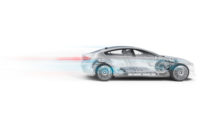Inspecting components for e-mobility applications is something that David Wick is very familiar with.
Wick, manager of product management at ZEISS Industrial Quality Solutions, has been working on a few different types of e-mobility applications for several years, including the battery, power electronics, e-motors and transmissions.
“Applications fit into several categories,” Wick says. “The first is e-motors, for measurement of the shape and insulation of the hairpins going into an electric motor. There we have to use a CMM with a noncontact optical sensor to measure the shape, and measure the thickness of varnish next to the wire.”
“As more and more companies are making electric motors for electric cars, along with that more and more companies are making battery trays,” Wick says. These may be five feet long and four feet wide, in a frame that holds all the batteries. This design allows for differences inside the vehicle as well, Wick points out.
If you’ve ever been in a Tesla, you’ll note that the floor is flat. This allows more room for passengers and is made possible because of the vehicle components. According to an article from Harvard Business Review, the Tesla hardware, including “ a flat pack of batteries at the base, two electric engines (front and rear), no transmission, etc.” provide advantages “such as a lower center of gravity, greater energy density, and more efficient battery management.”
While some inspection technologies are the same whether or not it’s an electric or traditional vehicle, there are some differences. Transmissions, for example, require a different approach.
“Because electric cars have a different type of transmission, they have to be extremely quiet,” Wick says. “The customer expects the electric car transmission to be silent. The gearing has to be very precise inside.”
This requires more precise—and more accurate—measurement. For a traditional transmission, manufacturers would use a CMM, though perhaps a less expensive and less precise machine.
Beyond transmissions, there are other applications that are unique to the e-mobility space. As Wick points out, electric motors and battery trays don’t exist in a traditional car.
So how to select the best inspection technology for your application? There are a few things to keep in mind. These are often tolerance- and project-specific, but there are a few overarching ideas that apply to a broader group.
“In looking for equipment, customers should look for a system where the sensors can be easily switched,” Wick says. If you’ve heard of plug and play for other technologies, this applies here as well.
“Look for plug and play sensors, because you don’t know, this year you may be measuring something with an active scanning sensor, but next week that could change.” By using a common programming software for all of them, the customer wouldn’t have to relearn it sometime down the road.
“The other thing we’re finding is look for a supplier that can provide credible and quick technical service,” Wick says. “Why would I say that? Think about that. If you’re building battery cases and have a contract to make 100,000 of them, you can’t wait around for someone to come and service a machine. You would need someone to visit the facility quickly if needed.”
Finally, he advises e-mobility customers to consider the reach of their potential partner. “A lot of companies getting into this business are global in nature,” Wick says. “Customers would be wise to think about, ‘Can the company I’m buying this from take care of me anywhere in the world?’ If I was in the market for these type of instruments, that’s what I would think about.”
Wick emphasizes that it is important to trust the supplier because when you get into the thick of production, you really don’t want to have to wait around for answers and disrupt production.
What’s Next?
With the rapid evolution in battery technology, there have been changing inspection requirements. “The name of the game in e-mobility is: how can I drive the available range of the car up?” Wick says. This means customers are closely watching the price of the vehicles as well as how many miles they can drive without recharging (range).
For both price and range, batteries can provide a solution. With the developments taking place in lithium ion batteries it is possible to extend the range and also lower the cost of the vehicle.
With the rise in battery manufacturers building plants in the United States—including Ohio, Georgia and Nevada—it seems that companies are betting on the American market and positioning themselves to be prepared for growth.
He predicts a timeline of late 2022 for more of these vehicles to be introduced. Since the U.S. government stopped giving tax rebates for e-vehicles, Wick says that suppliers are now working on getting the price down and improving the batteries.
There has been more interest in these type of inspection applications, Wick notes, even with the current environment.
Though the market involves a small set of companies—dozens, not thousands, of companies are involved in this space—it is growing.
These new e-mobility applications mostly use technology that is already available, which is a reassuring element for both manufacturers and suppliers, Wick says. It solves a new challenge but it is a proven technology.
“We know it works, and customers trust us.”




